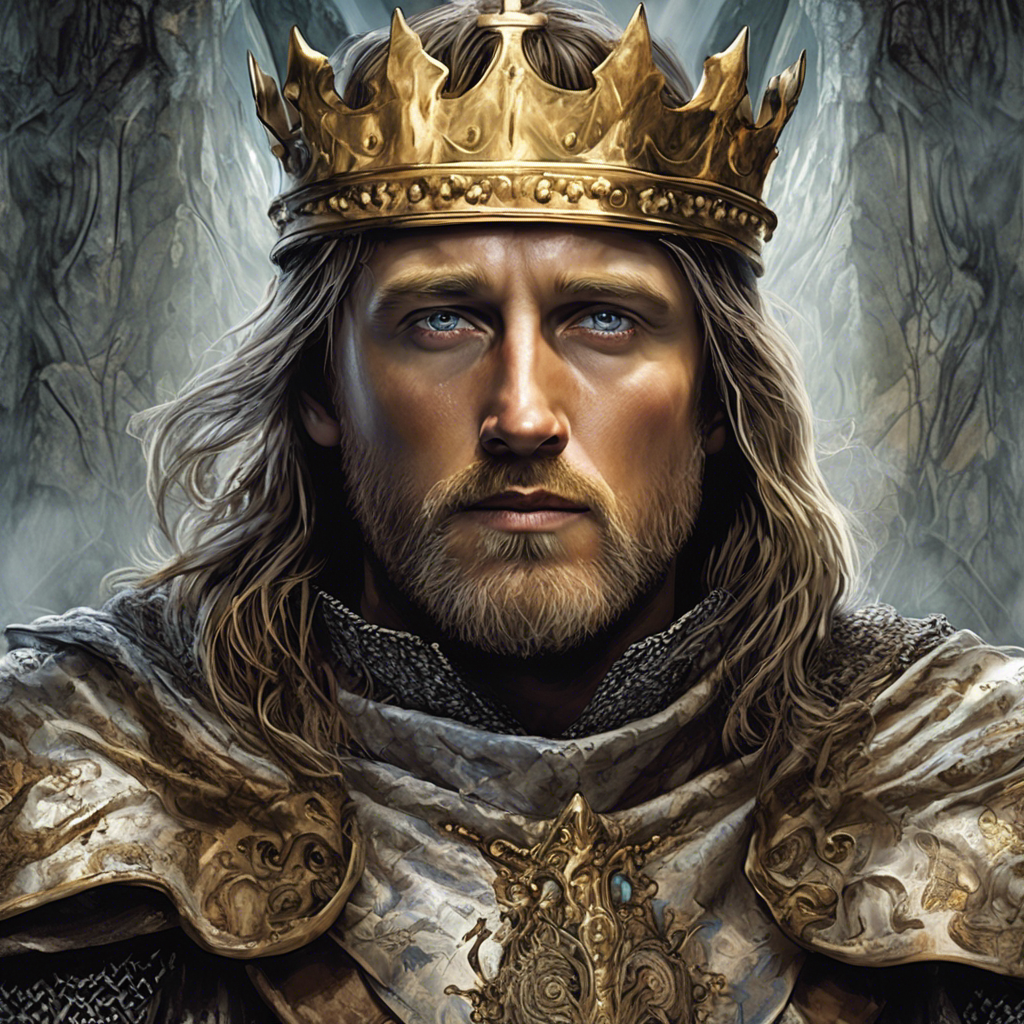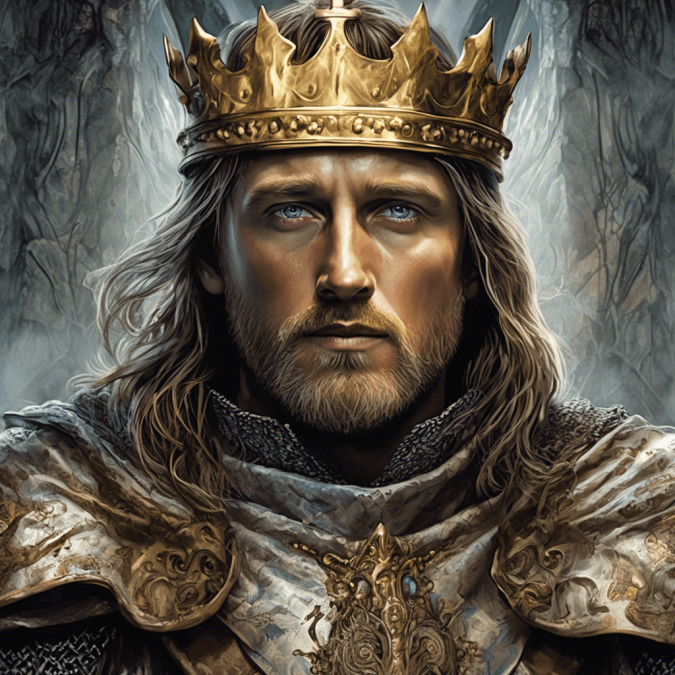
King Arthur is a legendary figure deeply rooted in British folklore and medieval literature. The tales of King Arthur and his Knights of the Round Table have captivated audiences for centuries, inspiring countless adaptations, interpretations, and creative works across various mediums.
The origins of the King Arthur legend are shrouded in mystery, with scholars debating whether he was a real historical figure or a purely mythical character. According to traditional Arthurian lore, King Arthur was a heroic leader who defended Britain against invading forces, particularly the Saxons, in the late 5th and early 6th centuries. He is often depicted as a noble and virtuous ruler, guided by the principles of chivalry and honor.
One of the most iconic elements of the Arthurian legends is the sword Excalibur, which Arthur received from the mystical Lady of the Lake. This legendary weapon was said to possess great power and was a symbol of Arthur’s rightful claim to the throne. In addition to Excalibur, Arthur is associated with other magical artifacts and figures, such as the wizard Merlin, who served as his advisor and mentor.
Central to the Arthurian mythos is the concept of the Knights of the Round Table, a group of noble and valiant knights who pledged to uphold the code of chivalry and protect the realm. Each knight had their own unique strengths and virtues, reflecting the diverse ideals of knighthood. The Round Table symbolized equality and unity among Arthur’s knights, emphasizing the importance of cooperation and camaraderie in the face of adversity.
The legend of King Arthur has been passed down through generations in various forms, including epic poems, romances, and historical chronicles. Some of the most famous literary works inspired by the Arthurian legends include Sir Thomas Malory’s “Le Morte d’Arthur,” T.H. White’s “The Once and Future King,” and Marion Zimmer Bradley’s “The Mists of Avalon.” These stories explore themes of love, betrayal, loyalty, and the quest for the Holy Grail, adding depth and complexity to the enduring myth of King Arthur.
In addition to literature, the Arthurian legends have been adapted into numerous films, television series, and theatrical productions, further solidifying Arthur’s status as a cultural icon. His tale continues to resonate with audiences around the world, serving as a timeless symbol of heroism, honor, and the enduring power of myth.
While the historical existence of King Arthur remains a subject of debate among scholars, his impact on literature, art, and popular culture is undeniable. Whether viewed as a legendary hero or a mythical archetype, King Arthur’s legacy endures as a testament to the enduring power of storytelling and the enduring appeal of medieval romance.
The story of King Arthur and the Knights of the Round Table is filled with a diverse cast of characters, each with their own unique traits, virtues, and flaws. Here are some of the key characters in the Arthurian legend:
1. King Arthur: The legendary king of Britain, known for his bravery, wisdom, and sense of justice. Arthur wields the magical sword Excalibur and leads his knights in defending the realm against threats and challenges.
2. Merlin: The powerful wizard and advisor to King Arthur, known for his prophetic abilities and magical powers. Merlin plays a pivotal role in guiding Arthur on his quest to become king and navigate the challenges he faces.
3. Guinevere: The queen of King Arthur and a symbol of beauty and grace. Guinevere’s love for Sir Lancelot leads to a tragic love triangle that ultimately brings about the downfall of Camelot.
4. Sir Lancelot: The most renowned and valiant of Arthur’s knights, known for his prowess in battle and his unwavering loyalty to the king. Lancelot’s forbidden love for Guinevere tests his commitment to the code of chivalry.
5. Sir Gawain: A noble and courageous knight of the Round Table, renowned for his sense of honor and loyalty. Gawain is often depicted as a gallant and chivalrous figure who upholds the ideals of knighthood.
6. Sir Galahad: The purest and most virtuous of Arthur’s knights, known for his unwavering faith and moral integrity. Galahad is chosen to achieve the quest for the Holy Grail due to his spiritual purity.
7. Sir Percival: A valiant knight who embarks on the quest for the Holy Grail, guided by his sense of duty and honor. Percival’s journey of self-discovery and redemption is a central theme in the Arthurian legends.
8. Sir Bedivere: One of Arthur’s most loyal knights, entrusted with returning Excalibur to the Lady of the Lake after the king’s death. Bedivere symbolizes loyalty, duty, and the passage of power from one generation to the next.
These are just a few of the many characters who populate the rich tapestry of the Arthurian legends, each contributing to the enduring appeal and complexity of the myth of King Arthur and the Knights of the Round Table. Their stories of heroism, honor, love, and betrayal continue to resonate with audiences around the world, showcasing the timeless themes and universal truths found in these legendary tales.
In the realm of ancient Britain, a land steeped in myth and legend, there lived a noble and valiant king named Arthur. As a young boy, Arthur was unaware of his royal lineage, having been raised in obscurity by the kindly Sir Ector. However, destiny had other plans for Arthur, as he was destined to become the greatest king the realm had ever known.
One fateful day, a mysterious sword appeared embedded in a stone in the courtyard of London. Engraved on the stone were the words: “Whoso pulleth out this sword of this stone and anvil is rightwise king born of all England.” Many knights and nobles attempted to pull the sword from the stone, but none succeeded until the young Arthur stepped forward and effortlessly withdrew the sword, revealing his true identity as the rightful king of Britain.
With Excalibur in hand, a magical sword bestowed upon him by the Lady of the Lake, Arthur embarked on a quest to unite the warring kingdoms of Britain under his rule. He established the legendary Round Table, a symbol of equality and unity, and gathered the bravest and most noble knights from across the land to serve as his companions and protectors.
Among Arthur’s most trusted knights were the gallant Sir Lancelot, the loyal Sir Gawain, the wise Sir Galahad, and the fierce Sir Percival. Together, they embarked on countless adventures and quests, battling dragons, giants, and wicked sorcerers in the name of justice and honor.
One of the most renowned quests undertaken by King Arthur and his knights was the search for the Holy Grail, a sacred relic said to possess miraculous powers. The knights faced countless trials and tribulations on their quest, testing their faith, courage, and resolve. Along the way, they encountered mystical beings, treacherous villains, and moral dilemmas that challenged their ideals and beliefs.
Despite his noble intentions and valiant deeds, King Arthur faced internal strife and betrayal within his own court. His queen, Guinevere, fell in love with Sir Lancelot, leading to a tragic love triangle that threatened to tear the kingdom apart. The seeds of discord sown by the traitorous knight Mordred eventually led to the downfall of Camelot and the tragic demise of King Arthur and his knights.
In the final battle of Camlann, Arthur faced Mordred in a fierce confrontation that resulted in both their deaths. As the kingdom of Camelot crumbled around them, Arthur entrusted the care of Excalibur to Sir Bedivere, instructing him to return the sword to the Lady of the Lake. With his dying breath, Arthur bade farewell to his loyal knights and the realm he had fought so hard to protect.
And so, the legend of King Arthur and his noble knights of the Round Table passed into memory, a timeless tale of heroism, honor, and sacrifice that continues to inspire and captivate audiences to this day. Though Camelot may have fallen, the legacy of Arthur lives on in the hearts and minds of those who believe in the enduring power of chivalry, courage, and the quest for truth and justice.
One of the most famous and enduring books that explores the legend of King Arthur is “Le Morte d’Arthur” by Sir Thomas Malory. This seminal work, first published in 1485, is a compilation of various Arthurian legends and romances that were popular in medieval England. “Le Morte d’Arthur” chronicles the life and adventures of King Arthur, his knights, and the quest for the Holy Grail, weaving together tales of chivalry, honor, betrayal, and love.
Sir Thomas Malory’s work is considered one of the most definitive interpretations of the Arthurian legend and has had a significant influence on subsequent portrayals of King Arthur in literature and popular culture. The book is divided into several books or sections, each focusing on different aspects of the Arthurian saga, from the birth of Arthur to his final battle against his traitorous son Mordred.
“Le Morte d’Arthur” explores themes of leadership, loyalty, and the complexities of human nature, presenting King Arthur as a flawed yet noble figure who strives to uphold the ideals of chivalry in a world filled with strife and treachery. The book also delves into the personal relationships and conflicts among Arthur’s knights, adding depth and emotional resonance to the legendary tales.
Sir Thomas Malory’s “Le Morte d’Arthur” remains a cornerstone of Arthurian literature and a must-read for anyone interested in delving into the rich tapestry of the King Arthur legend. The book has been widely acclaimed for its vivid storytelling, memorable characters, and timeless themes that continue to resonate with readers of all ages.
